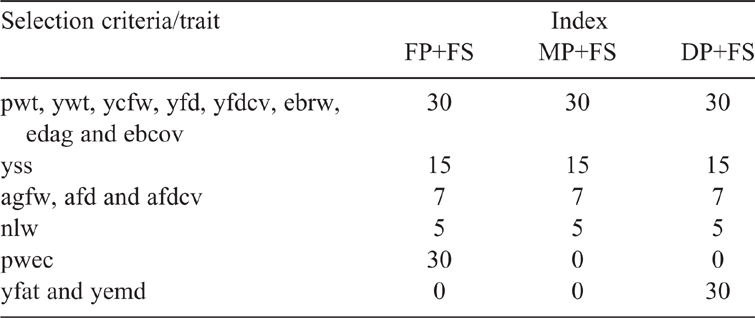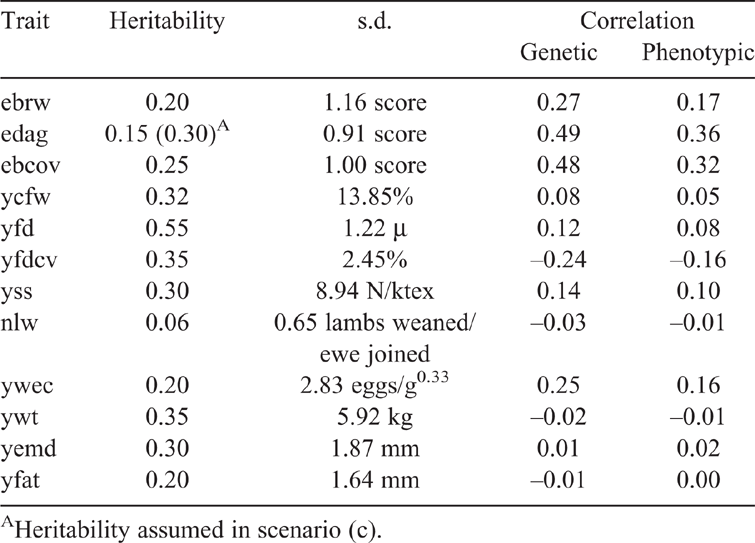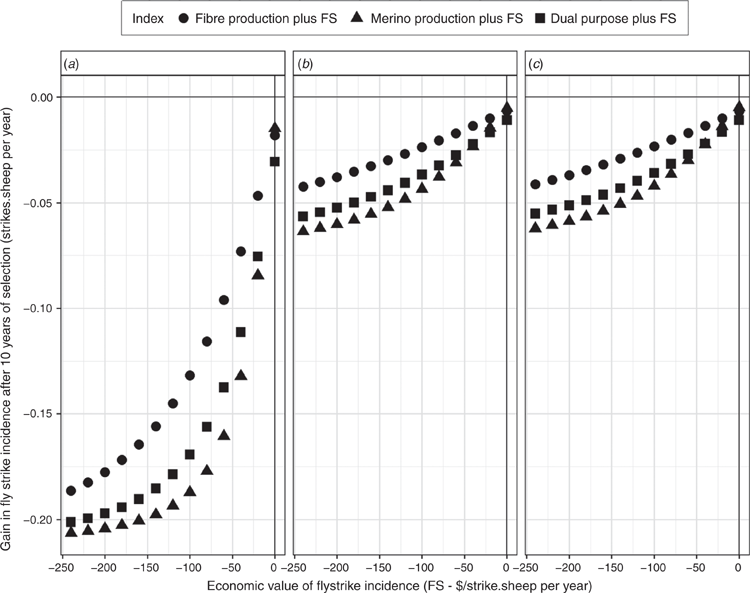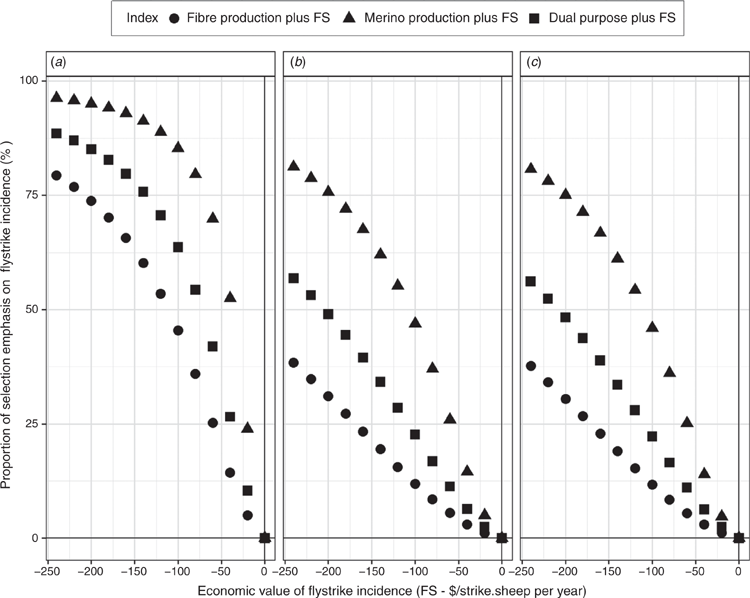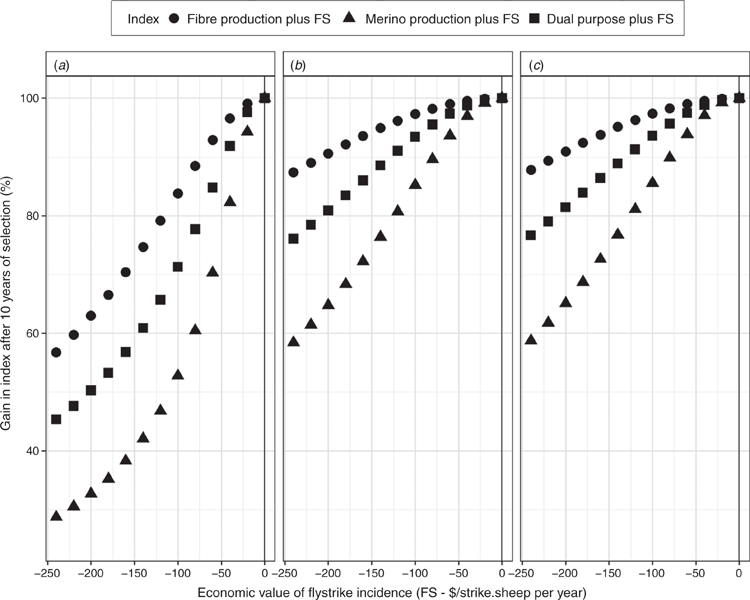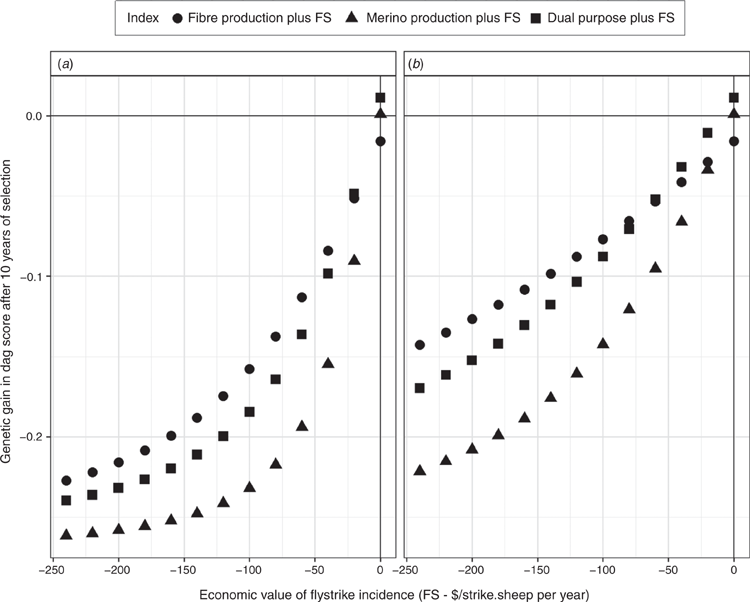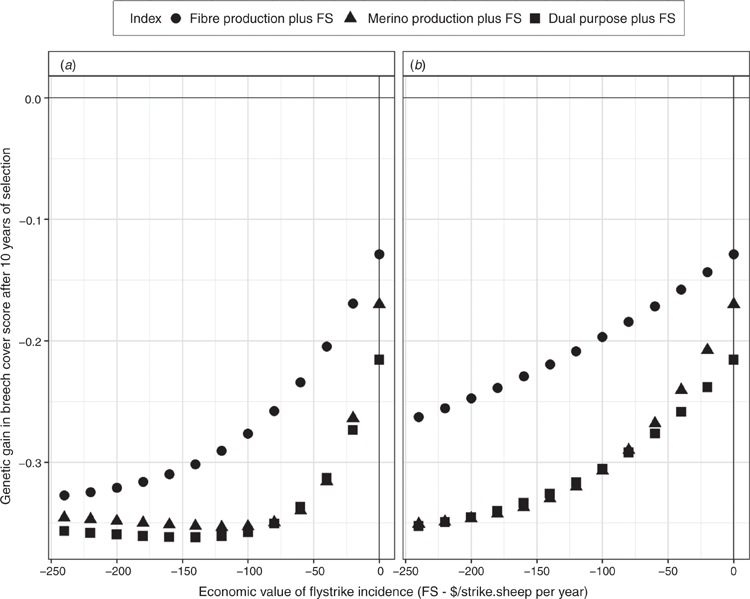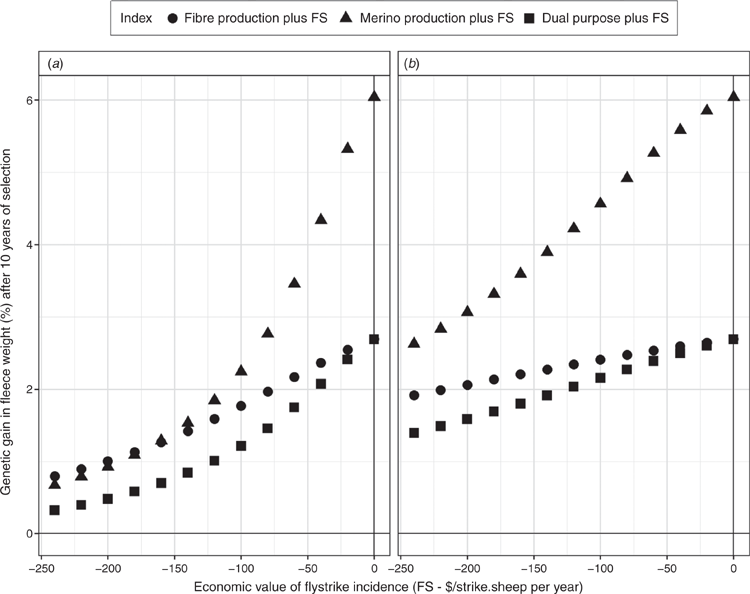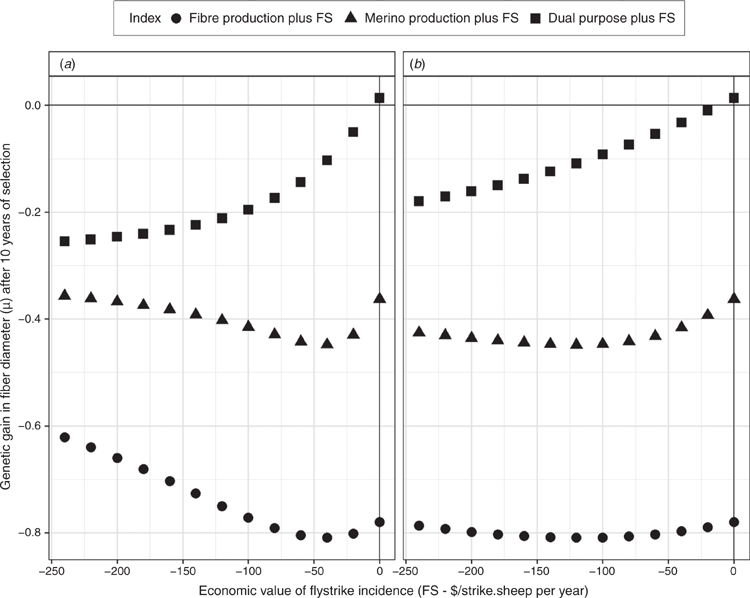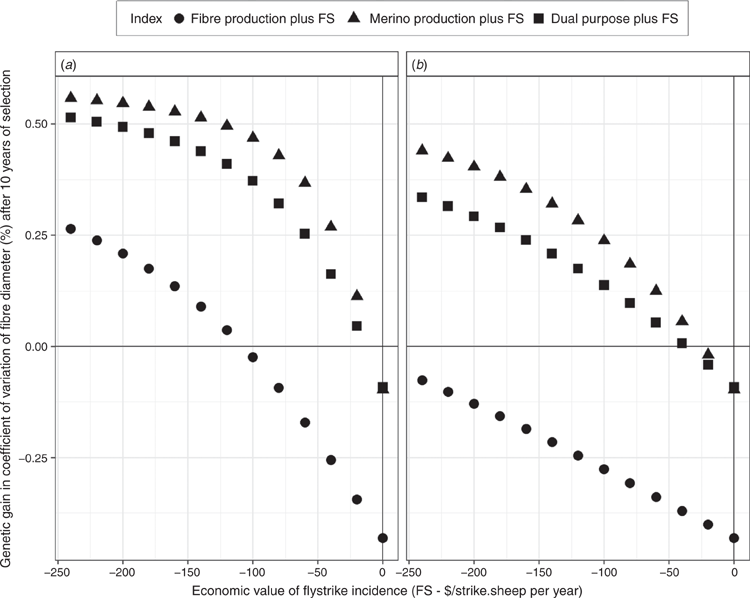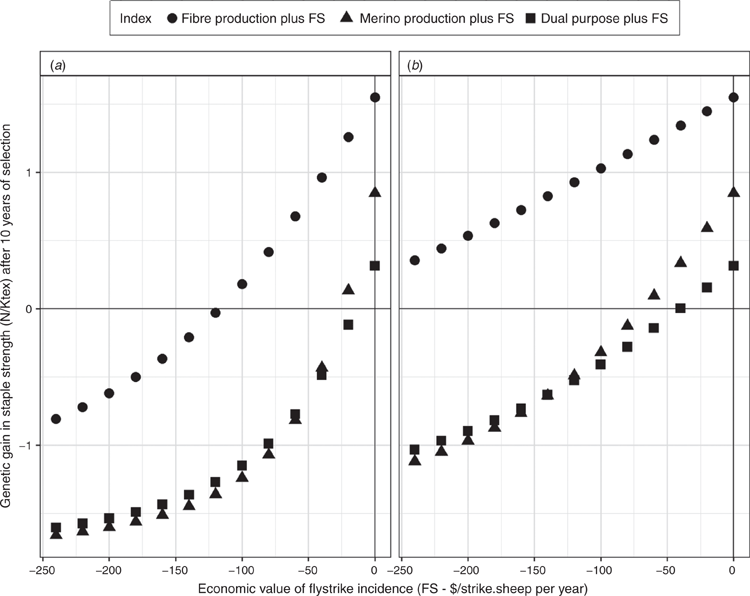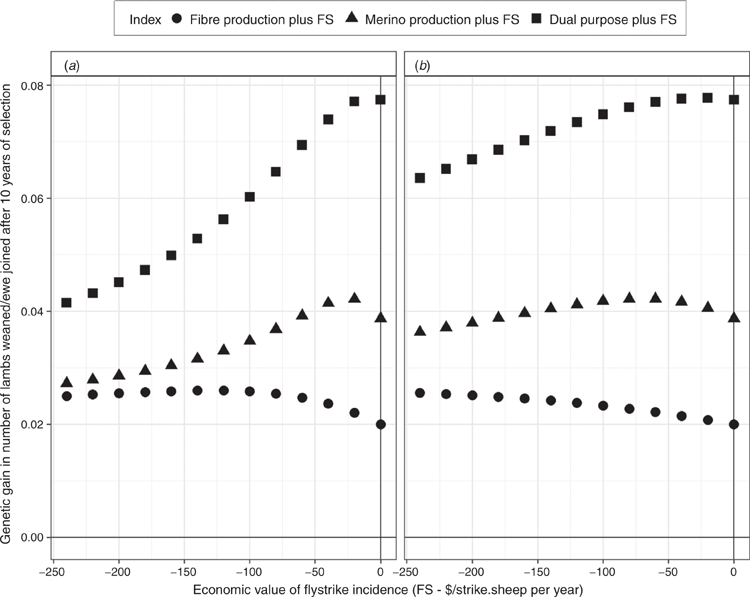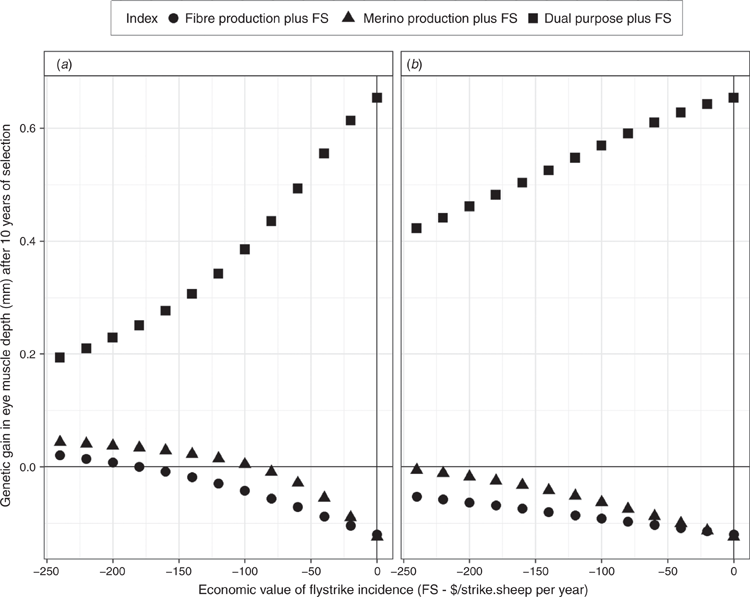Substantial genetic gains in reducing breech flystrike and in improving productivity traits are achievable in Merino sheep by using index selection
F. D. Brien A C , S. F. Walkom B , A. A. Swan
A C , S. F. Walkom B , A. A. Swan  B and D. J. Brown
B and D. J. Brown  B
B
A Davies Livestock Research Centre, School of Animal and Veterinary Sciences, University of Adelaide, Roseworthy, SA, 5371, Australia.
B Animal Genetics and Breeding Unit (a joint venture of the NSW Department of Primary Industries and University of New England), University of New England, Armidale, NSW 2351, Australia.
C Corresponding author. Email: forbes.brien@adelaide.edu.au
Animal Production Science - https://doi.org/10.1071/AN20248
Submitted: 22 April 2020 Accepted: 28 September 2020 Published online: 20 October 2020
Journal Compilation © CSIRO 2020 Open Access CC BY-NC-ND
Abstract
Context: The availability of effective indirect rather than direct selection criteria for genetically reducing breech flystrike is crucial for the Australian wool industry, as expression of breech flystrike is routinely suppressed by management interventions to minimise the risks to sheep health, welfare and productivity. Understanding how much genetic gain can be made in reducing breech strike, while also selecting for other key traits is important in choosing breeding objectives, particularly for Merino genetic improvement programs.
Aims: We predicted genetic gains from within-flock selection to reduce breech flystrike incidence (FS) and improve productivity under a range of scenarios that all used indirect selection criteria in the genetic evaluation of FS.
Methods: Three breeding objectives were modelled, by adding FS as a trait to the breeding objective for the Dual Purpose Plus (DP+), Fibre Production Plus (FP+) and Merino Production Plus (MP+) indexes available from MERINOSELECT. A large range of economic values were examined for FS, from 0 to –$240/strike.sheep per year in $20 increments. For all scenarios, full records of productivity traits and pedigree information were assumed to be available for use as selection criteria, as well as records of breech wrinkle, dag and breech cover scores. Predictions were conducted for scenarios assuming (a) moderate heritability for FS (b) low heritability for FS, and (c) low heritability for FS, but higher heritability for dag score than assumed for scenarios (a) and (b).
Key results: After 10 years of selection, under assumption (a) predicted genetic gains in FS ranged from 0, up to maximum reductions of 0.19, 0.21, and 0.20/strike.sheep per year from use of the FP+FS, MP+FS and DP+FS indexes, respectively. Under assumption (b) predictions of genetic gain for FS were considerably lower and ranged from 0 to maximum reductions of 0.04, 0.06 and 0.06/strike.sheep per year based on use of FP+FS, MP+FS and DP+FS indexes, respectively. Under assumption (c), predicted genetic gains in FS were very similar to those under assumption (b). When 70% of the maximum gains in FS studied were targeted, from 70% to 93% of genetic gains in the overall index (excluding FS) were predicted to be retained when FS had moderate heritability, and from 85% to 95% when FS had low heritability.
Conclusions and implications: There is a practical range of economic values for FS (from –$60 to –$80/strike.sheep per year for MP+FS and DP+FS indexes and –$60 to –$140/strike.sheep per year for a FP+FS index when the heritability of FS is moderate and –$100 to –$200/strike.sheep per year for a MP+FS index and –$140 to –$240/strike.sheep per year for FP+FS and DP+FS indexes when the heritability of FS is low), that could be used in breeding programs to genetically reduce FS, while retaining competitive levels of genetic gains for other important traits. Reduction of FS is achievable to low levels, after 10–20 years of index selection, similar to levels achieved by mulesing (0.01/strike.sheep per year in average seasonal conditions).
Keywords: breech, breech cover, breech indicator traits, breech wrinkle, dag score, flystrike, heritability, indirect selection, Merino, MERINOSELECT indexes, sheep.
Introduction
Flystrike, cutaneous myiasis, remains one of the major diseases affecting the Australian sheep industry, estimated to cost $173 million annually (Lane et al. 2015). Flystrike in the breech (crutch and tail) region of the sheep accounts for the majority of incidence in most years (James 2006), with surgical mulesing, regular crutching and application of insecticides either by preventative jetting or treatment of individual struck sheep remaining the predominant management procedures to control the problem. Docking tails at the optimal length, at the third palpable joint, to the tip of the vulva in ewes, is also critical to keeping breech flystrike to a minimum, regardless of whether the sheep are mulesed or not (Lloyd 2012).
With the practice of mulesing under scrutiny due to social and ethical concerns (Blackman 2005; James 2006), in 2005 the Australian wool industry rekindled its support for finding genetic solutions to controlling flystrike. Published reports of research conducted since then have progressively emerged over the past decade (Greeff and Karlsson 2009; Smith et al. 2009b; Brown et al. 2010; Richards and Atkins 2010; Greeff et al. 2014, 2018a, 2018b, 2019; Walkom and Brown 2014). These reports confirm that there is considerable genetic variation for breech flystrike and scores of breech wrinkle, breech and crutch cover, dag and urine stain, breech traits that are all genetically correlated with breech flystrike and could be useful indirect selection criteria. Recording the incidence of flystrike, including in the breech is not a normal part of phenotyping in ram breeding flocks and is not part of current national genetic evaluation in Australia. One of the main limitations to phenotyping is that the incidence of flystrike is routinely suppressed by management interventions for economic and welfare reasons. Hence indirect selection based on breech indicator traits rather than direct selection is crucial for industry in achieving genetic reductions in incidence of breech flystrike.
In earlier studies focused on genetically reducing breech wrinkle rather than directly on reducing breech flystrike incidence, Brown et al. (2010) and Richards and Atkins (2010) concluded that reductions of 0.4 to 0.7 of a wrinkle score are possible after 10 years of index selection while obtaining reasonable genetic gains in productivity traits. Brown et al. (2010) further advised that the use of across-flock variation in breech wrinkle would make the task easier than relying solely on within-flock selection. Richards and Atkins (2010) also reported that the time taken to reduce breech wrinkle in commercial flocks from using average stud rams could be reduced significantly by selecting rams of higher merit from the same stud and by ewe selection in commercial flocks. Neither Brown et al. (2010) nor Richards and Atkins (2010) studied the impact of using dag and breech cover scores as selection criteria for lowering breech strike incidence, in addition to breech wrinkle.
With the wide availability of Australian Sheep Breeding Values for breech traits and publication of accurate genetic parameters for breech flystrike incidence, breech wrinkle, dag and breech cover scores and their correlations with production traits (Greeff et al. 2016, 2019; Smith 2016; Hatcher and Preston 2017, 2018) there is now scope to predict gains in reducing breech flystrike incidence from selection indexes incorporating indirect selection criteria based on the available breech indicator traits of breech wrinkle, dag and breech cover scores rather than simply predicting genetic changes in breech wrinkle as reported in previous publications. This paper predicts genetic gains in reducing breech flystrike incidence under index selection for a range of different breeding objectives within three different scenarios, using modified MERINOSELECT indexes that include an expanded range of selection criteria.
Materials and methods
A model written in R by two of the co-authors was used for predicting genetic gains from selection in Merino sheep, with the methodology being similar to the approach of Rutten et al. (2002). Responses to selection were calculated for three different MERINOSELECT indexes, each either with or without modification to include breech flystrike incidence (FS) in the breeding objective. The modified indexes were named Fibre Production Plus and FS (FP+FS), Merino Production Plus and FS (MP+FS), and Dual Purpose Plus and FS (DP+FS). The unmodified MERINOSELECT indexes, FP+, MP+ and DP+ are available as standard options from the MERINOSELECT service offered by Sheep Genetics (Sheep Genetics 2019), with predicted results (not shown in the paper) from their use forming a base to calculate the impact of including selection for FS (when the modified indexes are used) on index gains. The FP+ index places a large emphasis on reducing fibre diameter, holding fleece weight (FW) constant, has some positive emphasis on staple strength (SS) and reproduction rate and also has a small negative emphasis on worm egg count. The MP+ index places a moderate emphasis on reducing fibre diameter, with large emphasis on increasing FW and seeks to also improve reproduction rate, SS and bodyweight. The DP+ index places a small emphasis on fibre diameter (FD) to hold it constant while increasing FW and also seeks to improve reproduction rate, bodyweight, carcass traits and staple strength. The economic values for these indexes were as reported by Brown and Swan (2016).
The economic value applied to breech flystrike incidence was varied from $0 to –$240 per strike/sheep.year (in $20 increments), to achieve a range of selection emphasis on breech flystrike prevalence (from zero to approaching 100%) from the three modified MERINOSELECT indexes. The economic value range used was empirically determined.
The prediction of genetic responses was conducted under three scenarios: (a) the heritability for FS is moderate (0.20 as per Smith 2016) (b) the heritability is low (0.10 as per Greeff et al. 2016); and (c) heritability is low as for (b), except that the heritability for dag score is high (0.3), in contrast to the standard assumption for MERINOSELECT indexes of 0.15 used in scenarios (a) and (b). The third scenario represents a situation where the incidence of dag is high, as in some Mediterranean environments in Australia.
Assumptions
The breeding program assumed a flock size of 500 breeding ewes with a flock age structure as outlined in Table 1, and is very similar to that assumed by Walkom and Brown (2014) and Brown and Swan (2016). This was close to the optimum structure for maximising genetic gain (within 3%), which used only 2- and 3-year-old rams, but the same number of ewe age groups.

|
The measurement/recording scenarios examined in this study were based on highly proactive ram breeders recording full pedigree information and measurements of the standard set of selection criteria required to obtain maximum benefit from use of the relevant MERINOSELECT index. The standard set of selection criteria were post-weaning weight (pwt, kg), yearling weight (ywt, kg), yearling clean FW (ycfw, %), yearling FD (yfd, µ) yearling coefficient of variation of FD (yfdcv, %), yearling SS (yss, N/ktex), adult greasy FW (agfw, %), adult FD (afd, µ), adult coefficient of variation of FD (afdcv, %), number of lambs weaned (nlw, lambs weaned/ewe joined), post-weaning worm egg count (WEC) (pwec, eggs/g0.33), yearling fat depth (yfat, mm) and yearling eye muscle depth (EMD) (yemd, mm). The selection criteria were expanded to include early breech wrinkle score (ebwr, score), early dag score (edag, score) and early breech cover score (ebcov, score). Further assumptions were:
-
65% of the selection emphasis was placed on the index values and the remaining 35% on other information sources, such as visual assessments;
-
a weaning rate of 90%;
-
annual mortality rate of adult sheep of 4%;
-
a generation interval of 2.97 years for males and 3.92 years for females;
-
the proportion of males selected was 2 and 48% for females, giving selection intensities of 2.43 and 0.828 respectively;
-
the ‘Bulmer effect’ (Bulmer 1971) results in a 30% loss in genetic gain, via reductions in variance; and
-
no preventative treatments were assumed to be applied for controlling breech strike or body strike.
In addition, the number of half-sib records assumed to be available for each selection candidate is outlined in Table 2.
The flystrike trait
The unit of the flystrike trait used was count of strikes per sheep over the flystrike season (an annual production cycle), similar to the definitions given by Greeff and Karlsson (2009) and (Smith et al. 2009b). Thus, the predicted genetic gains for flystrike refer to the change in number of strike.sheep per year over a 10-year period. This paper refers to the trait as breech FS.
Other traits
Predicted genetic gains for body wrinkle score and adult weight, in addition to the traits already listed, are provided in the paper, as correlated traits of interest.
Genetic parameters
For the standard production traits in the modified MERINOSELECT indexes, genetic predictions used the current Sheep Genetics parameters. The heritabilities and phenotypic standard deviations of these traits and their genetic and phenotypic correlations with FS assumed in this study are provided in Table 3 and are based on an average of industry estimates.
These genetic parameters were based on an average of available estimates from the scientific literature, with preference given to estimates from data from unmulesed animals that had been crutched in between shearing events (Greeff and Karlsson 2009; Smith et al. 2009a, 2009b; Brown et al. 2010; Richards and Atkins 2010; Bird-Gardiner et al. 2013, 2014; Greeff et al. 2016, 2018a, 2018b, 2019; Smith 2016; Hatcher and Preston 2017, 2018).
Calculation of selection emphasis
Selection emphasis (%) on the FS trait was calculated as follows:

Results
Capacity of index selection to reduce breech flystrike incidence
Where FS had a moderate heritability (20%), predicted genetic gains in reducing FS were 3–5 times as large as gains predicted when heritability for FS was low (10%), (Fig. 1). When the heritability of FS was moderate (Fig. 1a), predicted genetic gains after 10 years of selection ranged from –0.015 to –0.031, when the economic value for FS is 0, to a maximum of –0.186 to –0.207/strike.sheep per year, when the economic value for FS was –$240/strike.sheep per year. Gains were predicted to be slightly less for the FP+ index and slightly more for the MP+ index compared with gains from using the DP+ index. At the highest economic value of –$240/strike.sheep per year, most (80% or more) of the selection emphasis available is being placed on reducing the incidence of flystrike (Fig. 2).
When heritability for FS was low (Fig. 1b), maximum genetic gains (associated with use of the highest economic value of –$240/strike.sheep per year for FS) after 10 years of index selection were predicted to be –0.04, –0.06 and –0.06/strike.sheep per year for the FP+FS, DP+FS and MP+FS indexes, respectively. When the heritability for dag score was assumed to be high (Fig. 1c), predicted genetic gains for FS remained very similar (–0.04, –0.06 and –0.06/strike.sheep per year for the FP+FS, MP+FS and DP+FS indexes, respectively) compared with scenarios where the heritability for dag score was low. As selection responses under scenarios (b) and (c) for most other traits were very similar, only where there were scenario differences will selection responses for a low FS heritability and high dag heritability scenario be separately presented.
Impact of selection for FS on index gains
Fig. 3 shows the genetic gains predicted for FS plotted against the percentage of genetic gain retained in overall index score when FS is excluded from the breeding objective. The response lines for all three indexes showed a similar pattern. When FS heritability was moderate, as the economic value for FS increased in magnitude, reduction in overall index gain was the lowest for the FP+FS index (maximum reduction of 43%) and the highest for the MP+FS index (maximum reduction of 84%). However, even at an economic value of –$100/strike.sheep per year, 50% of genetic gain for the index is retained using a MP+FS index, while achieving 91% of the genetic gains for FS at the highest economic value studied (Fig. 1).
When FS heritability was low (Fig. 3b, c), although the shape of the response lines for index gains is similar to that for moderate FS heritability and for the three indexes, the reductions in index gains were less (maximums of 13 to 41%) with increasing magnitude of economic value for FS. At an economic value of –$100/strike.sheep per year, 86% of genetic gain for the MP + FS index was retained.
Impact of selection for FS on genetic gains of individual traits
Breech and body wrinkle score
Breech wrinkle score was predicted to reduce the most after 10 years of selection using a DP+FS index (reductions from 0.3 to 0.4 of a score) and the least with a FP+FS index (from an increase of 0.1 to a reduction of 0.2 of a score), with predictions from using a MP+FS index ranging from a small increase of 0.05 to a reduction of 0.25 of a score (Fig. 4). When the heritability of FS was moderate, after 10 years of selection with a FP+FS index, it was only at economic values of –$60/strike.sheep per year and more for FS that a genetic reduction in ebwr was predicted. With a low heritability for FS, economic values of –$140 and more were required to obtain small genetic reductions in ebwr with a FP+FS index. The pattern of genetic changes in body wrinkle score after 10 years of index selection were very similar to those in ebwr, given the high genetic correlation between the two traits and are presented in supplementary material.
Dag score
After 10 years of selection with a FP+FS index, edag was predicted to reduce more than ebwr. Maximum reductions predicted were 0.23 when heritability was moderate for FS and 0.14 when heritability was low for FS (Fig. 5). However, edag changes were predicted to be lower than genetic responses in ebwr with a DP+FS index, with a maximum reduction of 0.24 of a score when FS (when using an economic value of –$240/strike.sheep per year) had a moderate heritability, and was 0.17 when the heritability of FS was low. However, when the heritability of FS was low and the heritability of edag was high, edag was predicted to reduce by 0.25 (at the maximum economic value for FS of –$240/strike.sheep per year) when using a MP+FS index, more than the reduction in ebwr (0.21, data not shown). When FS had a moderate heritability, predicted reductions in edag with using a MP+FS index were similar to the reductions predicted for ebwr (maximums of 0.26 vs 0.27, respectively, when the economic value for FS was –$240/strike.sheep per year).
Breech cover score
Predicted changes for ebcov after 10 years of selection were considerably more than those for ebwr when using a FP+FS index and also a MP+FS index, but were similar in magnitude when using a DP+FS index (Fig. 6). Maximum predicted genetic reductions in ebcov after 10 years of selection were 0.33, 0.35 and 0.36 of a score for the FP+FS, MP+FS and DP+FS indexes, respectively (economic value of –$240/strike.sheep per year for FS) and were similar for both low and moderate heritabilities of FS.
Fleece weight
The highest gains for FW were predicted when no economic value is assigned to FS (Fig. 7). For all indexes, when FS had a low heritability, genetic gains in FW were predicted to be only marginally reduced (by less than 20%) unless the economic value assigned for FS was higher than –$80/strike.sheep per year. The equivalent reductions in genetic gain for FW when FS had a moderate heritability and was assigned an economic value of –$80/strike.sheep per year were predicted to be 27, 54 and 46% for the FP+FS, MP+FS and DP+FS indexes, respectively. For all scenarios considered, the modified MERINOSELECT indexes did not result in a decline in the FW of the flock.
Fibre diameter
Increasing the magnitude of economic value (and thus selection emphasis) assigned to reducing FS was associated with increased genetic gains in reducing FD, for economic values of FS up to –$60/strike.sheep per year (Fig. 8). Above economic values for FS of –$80/strike.sheep per year and selecting on FP+FS or MP+FS indexes, genetic gains for FD were reduced in magnitude, but only at a relatively low rate. This was not the case when using a DP+FS index, where increasing the magnitude of the economic value for FS also increased the genetic gain for FD, albeit from a low base.
Coefficient of variation in fibre diameter
Unlike genetic gains in FD, increasing the magnitude of economic value for FS was consistently associated with decreasing genetic gains in coefficient of variation in FD (FDCV), regardless of the scenarios investigated (Fig. 9). However, the magnitude of these changes were relatively minor, with the largest being a change from –0.43% (favourable gain) to +0.26% FDCV (unfavourable) after 10 years of selection with an FP+FS index, for economic values of zero and –$240/strike.sheep per year respectively.
Staple strength
Similar to the predictions for FDCV, increasing the magnitude of economic value given to FS was associated with decreases in the rate of genetic gain for SS in all scenarios investigated (Fig. 10). With the FP+FS index having positive selection emphasis on SS, the rates of genetic gain were larger than those predicted for the DP+FS and MP+FS indexes.
Number of lambs weaned per ewe joined
The predicted results for genetic gain in number of lambs weaned per ewe joined (NLW) while selecting for reduced FS varied with the selection index used and the FS heritability assumed (Fig. 11). When using an FP+FS index and FS heritability was low, genetic gains in NLW were predicted to consistently rise with increasing magnitude of economic value for FS. Similarly, when FS heritability was moderate, genetic gains for NLW increased with increasing magnitude of FS economic values up to –$120/strike.sheep per year, but then tapered off after that.
In contrast, when using a DP+FS index, genetic gains in NLW reduced with economic values for FS of –$40/strike.sheep per year and larger, with the reductions being larger when FS heritability was moderate compared with low. At the highest FS economic value of –$240/strike.sheep per year, after 10 years of selection with a DP+FS index, genetic gain was 45% less at 0.04 lambs weaned per ewe joined for moderate FS heritability and 17% less at 0.06 lambs weaned per ewe joined for low FS heritability compared with a genetic gain of 0.08 lambs weaned per ewe joined when FS had no economic value.
The predicted genetic gains in NLW from using an MP+FS index were intermediate between the DP+FS and the FP+FS indexes. When FS heritability was moderate, genetic gains in NLW using a MP+FS index were slightly higher or maintained until the magnitude of the economic value for FS increased above –$60/strike.sheep per year, after which genetic gains declined by 33% (compared with no economic value for FS) at an economic value of –$240/strike.sheep per year. For low FS heritability, genetic gains for NLW when using a MP+FS index were slightly higher (than for no FS economic value) for FS values up to –$160/strike.sheep per year.
Worm egg count
Increasing the magnitude of economic value for FS was associated with increasing favourable genetic gains for WEC in general (Fig. 12). Further, for the FP+FS index (the only index that has selection emphasis on reducing WEC), genetic gains after 10 years of selection were considerably larger than genetic gains predicted when using either a MP+FS or a DP+FS index. Genetic gains for WEC were the least with the MP+FS index, with reductions in WEC only predicted at FS economic values above –$20 to –$40/strike.sheep per year.
With moderate FS heritability, genetic gains for WEC cease to increase at FS economic values greater than –$180/strike.sheep per year for the FP+FS index and greater than –$100 for the DP+FS index. Genetic gains in WEC were in general similar for either moderate or low FS heritability, although there was less tapering of genetic reductions for WEC at higher FS economic values with low FS heritability.
Yearling and adult weights
Compared with no selection emphasis for FS, there was very little change in genetic gains predicted for yearling weight following 10 years of selection using a FP+FS index (Fig. 13). However, genetic gains declined with increasing magnitude of economic value for FS when using both MP+FS and DP+FS indexes, with the declines in genetic gain for yearling weight approximately double when FS heritability is moderate compared with low. The pattern of responses of genetic gain for adult weight when selecting for FS as part of index selection were higher, similar to that for yearling weight (see Figures S1–S3 available as Supplementary Material to this paper).
Eye muscle and fat depths
The predicted genetic gains in EMD varied with the index used (Fig. 14). Following 10 years of selection using a DP+FS index (the MERINOSELECT DP+ index giving selection emphasis to carcass traits), genetic gains in EMD consistently declined with increasing magnitude of economic value for FS but remained positive, with declines larger with moderate heritability for FS compared with low. Genetic gains of 0.19 mm in EMD were predicted at the largest FS economic value of –$240/strike.sheep per year with moderate FS heritability and 0.42 mm with low FS heritability, down from 0.65 mm when FS received no selection emphasis.
In contrast, predicted genetic gains in EMD consistently increased with increasing magnitude of economic value for FS following 10 years of selection using either a FP+FS or a MP+FS index, albeit from a negative base of –0.12 mm of genetic gain when FS received no selection emphasis.
The patterns of genetic gains predicted in fat depth following 10 years of selection for each of the three MERINOSELECT indexes modified to include FS were similar to those for genetic gains in EMD (see Supplementary Material).
Discussion
Substantial genetic reductions in flystrike incidence are predicted in our study, when selecting with modified MERINOSELECT indexes that include FS as a part of breeding objectives. This occurs while maintaining acceptable levels of genetic improvement in other traits. For example, using an economic value for FS of –$80/strike.sheep per year and a heritability of FS of 0.20 applicable to a summer rainfall environment, predicted genetic reductions after 10 years of selection are 0.12, 0.18 and 0.16/strike.sheep per year for the FP+FS, MP+FS and DP+FS indexes, respectively. These genetic gains are predicted whilst maintaining 60–88% of the index gains available for the breeding objective when FS is excluded. Using the same economic value of –$80 for FS, but a lower heritability of 0.10 for FS applicable to a winter rainfall environment FS, smaller reductions of 0.02 to 0.04 strikes/sheep.year in FS are predicted after 10 years of index selection, whilst maintaining 90–98% of genetic gains available in index score for the breeding objective when FS is excluded.
Our predictions have been made assuming a high level of performance recording of traits (i.e. all selection criteria traits on selection candidates and records from relatives) and pedigree collection by breeders. For breeding enterprises not operating at this high level of recording, achieving genetic reductions in FS is likely to take considerably longer. For instance, becoming a well recorded flock can take 2–6 years to achieve, depending on how much data is currently collected (G. Lindon, AWI Ltd., pers. comm.).
Our results are broadly similar to earlier predictions for ram breeding flocks though the predicted gains in breech wrinkle in our study are somewhat less than those predicted by Brown et al. (2010) and Richards and Atkins (2010). It is important to note that those studies were based on adding breech wrinkle as both a breeding objective and selection criteria to the standard MERINOSELECT index (and breeding objective) options available at the time, whereas our study used breech wrinkle, dag and breech cover as selection criteria only for flystrike incidence.
Breech flystrike incidences in crutched but unmulesed young sheep not receiving preventative chemical treatments have been reported to average 0.18 and 0.08 strikes/sheep.year (weaners and yearlings respectively) in a summer rainfall environment in NSW (Smith 2016) and from 0.04 to 0.1 strikes/sheep.year, from birth to hogget shearing, in a winter rainfall environment in WA (Greeff et al. 2016). Using those incidences of flystrike as a guide, in a winter rainfall environment, our predicted gains suggest that after 10–20 years of index selection in a ram breeding flock, FS could be reduced in crutched but unmulesed sheep (with no preventative chemical treatments) to low levels (0.01 strike.sheep per year or less) in years of average flystrike incidence, given sufficient selection emphasis on reducing FS (economic values of –$80 to –$200 per sheep/year). For a summer rainfall environment, with moderate FS heritability, despite average flystrike incidence being higher, our index selection predictions suggest that a target of 0.01/strike.sheep per year (or less) in crutched but unmulesed sheep (with no preventative chemical treatments) in a ram breeding flock might be achievable in less than 10 years, particularly if using an economic value for FS –$60/strike.sheep per year or more. Reducing FS to 0 in all years is almost impossible as environmental (and possibly non-additive genetic) variation will remain, despite selection efforts to reduce it. Further, it is important to balance potential gains in reducing FS with the predicted impact on genetic gains for other important traits to optimise economic gains.
Available industry data on breech strike risk in Australian Merino sheep is largely from mulesed flocks, with the average incidence from a recent survey reported to be 1% (0.01 strikes/sheep.year) in mixed-age Merino ewes. The majority of survey respondents also indicated that they commenced treating mobs, rather than struck animals as individuals, when the incidence of flystrike reaches 1% (AWI 2019). A breeding objective for reducing flystrike incidence in crutched but unmulesed sheep in Australia (without preventative chemical treatment) to 0.01 strike.sheep per year, approximately the level of incidence reported for mulesed Merino sheep would thus seem a reasonable aim.
To reduce flystrike incidence by genetic means, it is clear that considerable selection emphasis needs to be applied to the trait. How much emphasis depends on the breeding objective chosen, which relates to the type of sheep enterprise being run and the typical incidence of flystrike being experienced. This is best illustrated by examples. A breeder in the spring-summer rainfall area near Armidale, NSW decides to reduce FS in their stud flock by 0.1/strike.sheep per year over 10 years while also pursuing significant genetic reductions in FD using a FP+FS index. Our results suggest that the breeder should use an economic value for FS of –$80/strike.sheep per year and that 88% of genetic gains in index score are likely retained of that achievable when FS is not part of the breeding objective. In contrast, for a ram breeder in a winter rainfall environment, where the heritability of FS is likely to be low, breeders using a MP+FS index targeting large gains in FW, along with modest gains in other productivity traits and also aiming to place a strong emphasis on reducing FS by 0.05/strike.sheep per year over 10–12 years need to consider using higher economic values of FS, such as –$120 to –$140/strike.sheep per year. At that level, 76–80% of the potential gain in overall index score is predicted to be retained when FS is excluded from the breeding objective.
The highest impact of selecting for FS on genetic gains in other individual traits in our study was on FW. However, the majority (62% or more) of the largest genetic gains for FS predicted could be achieved while retaining at least 46% of the potential genetic gains for FW when FS has an economic value of 0 (Brien et al. 2019). This retention of FW gains is higher than that predicted from within-flock selection by Brown et al. (2010) and Richards and Atkins (2010), noting that they used breech wrinkle score as a proxy for FS in breeding objectives. However, Brown et al. (2010) noted that if across-flock variation could be exploited (as well as within-flock variation), more FW gains could be retained while also selecting for lower wrinkle scores.
The predicted impacts of selecting for FS on genetic gains for other key traits were mostly small, especially when economic values for FS do not exceed –$80 when FS heritability is moderate and –$120/strike.sheep per year when FS is low. The minor impacts of FS selection on genetic gains for FD in our study are similar to the within-flock selection predictions of Brown et al. (2010) and Richards and Atkins (2010). The minor adverse effects of FS selection on the coefficient of variation for FD and for SS vary from the small but positive gains predicted by Brown et al. (2010) and might be explained by differences in genetic parameter assumptions and in selection criteria, but also as breech wrinkle was the trait included in the breeding objective rather than FS as reported here. If the results of this study are borne out in practice, the unfavourable genetic trends in FDCV and SS could be corrected with placing some selection emphasis on the traits when constructing selection indexes.
The predicted increases in genetic gains for reproductive rate of 10–30% when using a FP+FS index is an added potential benefit for fine-wool breeders aiming to reduce FS and is consistent with research findings that plainer-bodied sheep are genetically likely to wean more lambs (Dun 1964; Dun and Hamilton 1965; Turner and Young 1969; Greeff et al. 2012; Matebesi-Ranthimo et al. 2018). However, strong selection emphasis on reducing FS (economic values in excess of –$60 to –$80/strike.sheep per year) when using a MP+FS and especially a DP+FS index may noticeably reduce genetic gains for NLW and would require careful evaluation before use in breeding programs.
In the absence of formally derived economic values for FS, an upper limit in practice could be chosen where no less than 60% of the genetic gain in index score is retained when FS is excluded from the breeding objective. Using that as a criteria for a low FS heritability scenario, the largest economic value studied of –$240/strike.sheep per year could be used with all three modified indexes. Alternatively, if ram breeders in a winter rainfall environment (low FS heritability) are more focused on maximising gains in FW than on overall index gains while also aiming to reduce FS, then an upper limit of –$200/strike.sheep per year is suggested. When FS heritability is moderate, the size of the economic value should not exceed –$80, –$140 and –$220/strike.sheep per year when using the MP+FS, DP+FS and FP+FS indexes respectively.
Genetic gains predicted in this study are based on within-flock estimates of genetic parameters and do not take account of any across-flock variance or differences in correlations between traits. From the report of Brown et al. (2010), breeders have the opportunity to exploit across-flock variation, so they may be able to achieve better results than predicted here. Finally, although attempts to locate genes or gene markers of large effect on FS have been unsuccessful, recent results suggest that selection accuracy could be improved by creating a genomic enhanced breeding value for FS (Dominik 2019). This could be done in tandem with direct progeny testing of elite sires for FS under close managerial supervision, as recommended recently by Greeff et al. (2019).
If implemented, this could significantly improve the rates of genetic gain for FS that are predicted in this study, which have relied on indirect selection based on scores of breech wrinkle, dag and breech cover.
Conclusions and recommendations
Substantial genetic reductions in flystrike incidence can be made after 10 years of selection based on modified MERINOSELECT indexes in well recorded flocks that utilise records of breech wrinkle, dag and breech cover scores as indirect selection criteria, in addition to selection criteria for productivity traits. The rates of genetic gains for reductions in flystrike incidence predicted in this study suggest that ram breeding flocks could reduce average FS to low levels (0.01 strike.sheep per year after 10–20 years of index selection in a Mediterranean winter rainfall environment and within 10 years in a summer rainfall environment).
Genetic reductions in FS are predicted to be much lower in a Mediterranean environment than in a summer rainfall environment due to differences in variance and heritability of FS applicable to the production systems in each of those environments. Changing the assumed heritability of correlated dag score from 0.15 to 0.3 made little difference to the predicted rates of genetic gain for FS.
There is a need to formally derive economic values for FS, for specific environments and production systems, with a view to incorporating FS as a formal trait in selection indexes offered to industry. Ponzoni (1984) calculated relative economic values for body flystrike in Merino sheep under a range of differing flystrike treatment regimes, with values being 10 times higher in the absence of any flystrike treatments compared with treating individual animals that become flystruck (a more realistic industry practice). An independent study on including selection against fleece rot (a pre-deposing condition to body strike) in a commercial Merino breeding program calculated economic values based on assumptions on the effects of the disease on production levels. Using those economic values, significant reductions in fleece rot were predicted, whilst obtaining competitive gains in production traits using index selection (Atkins, 1987). Similar approaches to these earlier studies could be applied to deriving economic values for selecting against breech flystrike. In the absence for formally derived economic values for FS, there is a sensible range (–$60 to –$80/strike.sheep per year for MP+FS and DP+FS indexes and –$60 to –$140/strike.sheep per year for a FP+FS index when the heritability of FS is moderate and –$100 to –$200/strike.sheep per year for a MP+FS index and –$140 to –$240/strike.sheep per year for FP+FS and DP+FS indexes when the heritability of FS is low) of economic values that could be utilised in a desired gains approach to genetically reduce flystrike incidence, balanced with retaining competitive gains in productivity traits as part of applying index selection in Merino breeding programs.
Finally, to boost genetic gain for FS, we recommend the development of genomic-enhanced breeding values for the trait which would require the development of a large reference flock.
Conflict of interest
The authors declare no conflicts of interest.
Acknowledgements
We acknowledge the support of Australian Wool Innovation Ltd (AWI). AWI is grateful for its funding, which is primarily provided by Australian woolgrowers through a wool levy and by the Australian Government which provides a matching contribution for eligible R&D activities. The authors acknowledge the contributions of the AWI/CSIRO/DPIRD Breeding for Breech Strike Resistance Flocks and other industry-funded research flocks. We would also like to thank the reviewers, one of whom made a large number of useful comments and suggestions that have helped in considerably improving the paper.
References
Atkins KD (1987) Resistance to fleece rot and body strike: its role in a breeding objective for Merino sheep. In ‘Proceedings of the Sheep Blowfly and Flystrike Management Workshop’, Trangie, NSW, Department of Agriculture, pp. 3.1–3.7.AWI (2019) 2017 Merino Husbandry Practices Survey. Available at https://www.wool.com/globalassets/wool/sheep/research-publications/welfare/surveys/2017-awi-merino-husbandry-practices-survey-website-version.pdf [Verified 23 January 2020]
Bird-Gardiner TL, Brown DJ, Smith JL, Mortimer SI, Refshauge G (2013) Inheritance of flystrike recorded in a non-seasonal rainfall environment. Proceedings of the Association for the Advancement of Animal Breeding and Genetics 20, 183–186.
Bird-Gardiner TL, Brown DJ, Smith JL, Mortimer SI, Refshauge G (2014) Breech strike indicator traits for Merino sheep in non-seasonal rainfall environments. In ‘Proceedings of the 10th World Congress on Genetics Applied to Livestock Production’, Vancouver, Canada. Communication 891. (World Congress on Genetics Applied to Livestock Production, Vancouver, British Columbia, Canada). Available at http://www.wcgalp.org/proceedings/2014/breech-strike-indicator-traits-merino-sheep-non-seasonal-rainfall-environments [Verified 7 October 2020]
Blackman N (2005) Mulesing of sheep in Australia – a global issue. Australian Veterinary Journal 83, 456
| Mulesing of sheep in Australia – a global issue.Crossref | GoogleScholarGoogle Scholar | 16119415PubMed |
Brien FD, Walkom SF, Swan AA, Brown DJ (2019) Breeding for reduced breech flystrike as part of multi-trait selection. Proceedings of the Association for the Advancement of Animal Breeding and Genetics 23, 528–531.
Brown DJ, Swan AA (2016) Genetic importance of fat and eye muscle depth in Merino breeding programs. Animal Production Science 56, 690–697.
| Genetic importance of fat and eye muscle depth in Merino breeding programs.Crossref | GoogleScholarGoogle Scholar |
Brown DJ, Swan AA, Gill JS (2010) Within- and across-flock genetic relationships for breech flystrike resistance indicator traits. Animal Production Science 50, 1060–1068.
| Within- and across-flock genetic relationships for breech flystrike resistance indicator traits.Crossref | GoogleScholarGoogle Scholar |
Bulmer MG (1971) Effect of selection on genetic variability. American Naturalist 105, 201–211.
| Effect of selection on genetic variability.Crossref | GoogleScholarGoogle Scholar |
Dominik S (2019) Genotyping of breech flystrike resource – update. Final Report of Project ON-00515. Australian Wool Innovation. July 2019. Available at https://www.wool.com/globalassets/wool/sheep/research -publicationswelfare/flystrike-research-update/on515-project-final-report-genotyping-of-breech-flystrike-resource-for-publication.pdf [Verified 29 August 2019]
Dun RB (1964) Skins folds and Merino breeding. 1. The net reproductive rates of flocks selected for and against skin fold. Australian Journal of Experimental Agriculture and Animal Husbandry 4, 376–385.
| Skins folds and Merino breeding. 1. The net reproductive rates of flocks selected for and against skin fold.Crossref | GoogleScholarGoogle Scholar |
Dun RB, Hamilton BA (1965) Skin folds and Merino breeding. 2. The relative influence of the ram and ewe on fertility and perinatal lamb mortality in flocks selected for and against skin fold. Australian Journal of Experimental Agriculture and Animal Husbandry 5, 236–242.
| Skin folds and Merino breeding. 2. The relative influence of the ram and ewe on fertility and perinatal lamb mortality in flocks selected for and against skin fold.Crossref | GoogleScholarGoogle Scholar |
Greeff JC, Karlsson LJE (2009) Opportunities to breed for resistance to breech strike in Merino sheep in a Mediterranean environment. Proceedings of the Association for the Advancement of Animal Breeding and Genetics 18, 272–278.
Greeff JC, Karlson J, Schlink AC, Stanwyck N, Underwood N (2012) Breed more robust sheep – less effort. Agribusiness Sheep Updates, University of Western Australia, Perth, WA.
Greeff JC, Karlsson LJE, Schlink AC (2014) Identifying indicator traits for breech strike in Merino sheep in a Mediterranean environment. Animal Production Science 54, 125–140.
| Identifying indicator traits for breech strike in Merino sheep in a Mediterranean environment.Crossref | GoogleScholarGoogle Scholar |
Greeff J, Karlsson J, Schlink AC, Stanwyck N, O’Neal R, Windsor A, Bell S (2016) Final Report to Australian Wool Innovation Ltd. Project ON-00169. Breeding for breech flystrike resistance. Phase 2. Department of Agriculture and Food WA, South Perth. Available at https://www.wool.com/globalassets/wool/sheep/research-publications/welfare/breeding/200826-on-169-dafwa-breeding-project-final-report—pub-app.pdf [Verified 28 August 2020]
Greeff JC, Karlsson LJE, Schlink AC, Gilmour AR (2018a) Factors explaining the incidence of breech strike in a Mediterranean environment in unmulesed and uncrutched Merino sheep. Animal Production Science 58, 1279–1288.
| Factors explaining the incidence of breech strike in a Mediterranean environment in unmulesed and uncrutched Merino sheep.Crossref | GoogleScholarGoogle Scholar |
Greeff JC, Schlink AC, Karlsson LJE (2018b) Impact of sire on the lifetime susceptibility of their progeny to breech strike in a Mediterranean environment. Animal Production Science 58, 1522–1530.
| Impact of sire on the lifetime susceptibility of their progeny to breech strike in a Mediterranean environment.Crossref | GoogleScholarGoogle Scholar |
Greeff JC, Karlsson LJE, Schlink AC (2019) Are breech strike, dags and breech wrinkle genetically the same trait in crutched, uncrutched and mulesed Merino sheep? Animal Production Science 59, 1777–1782.
| Are breech strike, dags and breech wrinkle genetically the same trait in crutched, uncrutched and mulesed Merino sheep?Crossref | GoogleScholarGoogle Scholar |
Hatcher S, Preston JWV (2017) Phenotypic relationships of breech cover, wrinkle and wool coverage scores with key production traits and their implications for Australian Merino sheep management to reduce flystrike. Small Ruminant Research 157, 47–53.
| Phenotypic relationships of breech cover, wrinkle and wool coverage scores with key production traits and their implications for Australian Merino sheep management to reduce flystrike.Crossref | GoogleScholarGoogle Scholar |
Hatcher S, Preston JWV (2018) Genetic relationships of breech cover, wrinkle and wool coverage scores with key production traits in Australian Merino sheep. Small Ruminant Research 164, 48–57.
| Genetic relationships of breech cover, wrinkle and wool coverage scores with key production traits in Australian Merino sheep.Crossref | GoogleScholarGoogle Scholar |
James PJ (2006) Genetic alternatives to mulesing and tail docking in sheep: a review. Australian Journal of Experimental Agriculture 46, 1–18.
| Genetic alternatives to mulesing and tail docking in sheep: a review.Crossref | GoogleScholarGoogle Scholar |
Lane J, Jubb T, Shephard R, Webb-Ware J, Fordyce G (2015) Priority list of endemic diseases for the red meat industries. Final report of project B.AHE.0010, Meat & Livestock Australia, North Sydney.
Lloyd J (2012) Tail length in unmulesed Australian Merino sheep. Report for Australian Wool Innovation, December 2012. Project Number WP599.
Matebesi-Ranthimo PAM, Cloete SWP, van Wyk JB, Olivier JJ (2018) Relationship of ewe reproduction with subjectively assessed wool and conformation traits in the Elsenburg Merino flock. South African Journal of Animal Science 48, 29–38.
| Relationship of ewe reproduction with subjectively assessed wool and conformation traits in the Elsenburg Merino flock.Crossref | GoogleScholarGoogle Scholar |
Ponzoni RW (1984) The importance of resistance to fleece rot and body strike in the breeding objective of Australian Merino sheep. Wool Technology and Sheep Breeding 32, 33–40.
Richards JS, Atkins KD (2010) Will genetics offer a permanent solution to breech strike? Animal Production Science 50, 1053–1059.
| Will genetics offer a permanent solution to breech strike?Crossref | GoogleScholarGoogle Scholar |
Rutten MJM, Bijma P, Woolliams JA, van Arendonk JAM (2002) SelAction: Software to predict selection response and rate of inbreeding in livestock breeding programs. The Journal of Heredity 93, 456–458.
| SelAction: Software to predict selection response and rate of inbreeding in livestock breeding programs.Crossref | GoogleScholarGoogle Scholar |
Sheep Genetics (2019) MERINOSELECT indexes. A ram breeder’s guide. http://www.sheepgenetics.org.au/Resources/Brochures-and-fact-sheets [Verified 17 March 2020]
Smith J (2016) Breeding for breech flystrike resistance, Phase 3 CSIRO. Project Final Report to Australian Wool Innovation Ltd. Project No. ON-00169 (WP.639). Available at https://www.wool.com/globalassets/wool/sheep/research-publications/welfare/breeding/200826-on-169-csiro-breeding-project-final-report—pub-app.pdf [Verified 28 August 2020]
Smith DH, Safari E, Brien FD, Jaensch KS, Grimson RJ (2009a) The relationships between crutch cover score and production and easy care traits in Merino sheep. Proceedings of the Association for the Advancement of Animal Breeding and Genetics 18, 338–341.
Smith J, Brewer H, Dyall T (2009b) Heritability and phenotypic correlations for breech strike and breech strike resistance indicators in Merinos. Proceedings of the Association for the Advancement of Animal Breeding and Genetics 18, 334–337.
Turner HN, Young SSY (1969) ‘Quantitative genetics in sheep breeding.’ (Macmillan Australia: Melbourne, Vic., Australia)
Walkom SF, Brown DJ (2014) Breeding for resilience and resistance in Merino sheep. In ‘Breeding focus 2014 – improving resilience’. (Eds S Hermesch, S Dominik) pp. 141–154. (Animal Genetics and Breeding Unit, University of New England: Armidale, NSW, Australia). Available at https://www.researchgate.net/publication/268632531_Breeding_Focus_2014_-_Improving_Resilience [Verified 20 August 2020]


